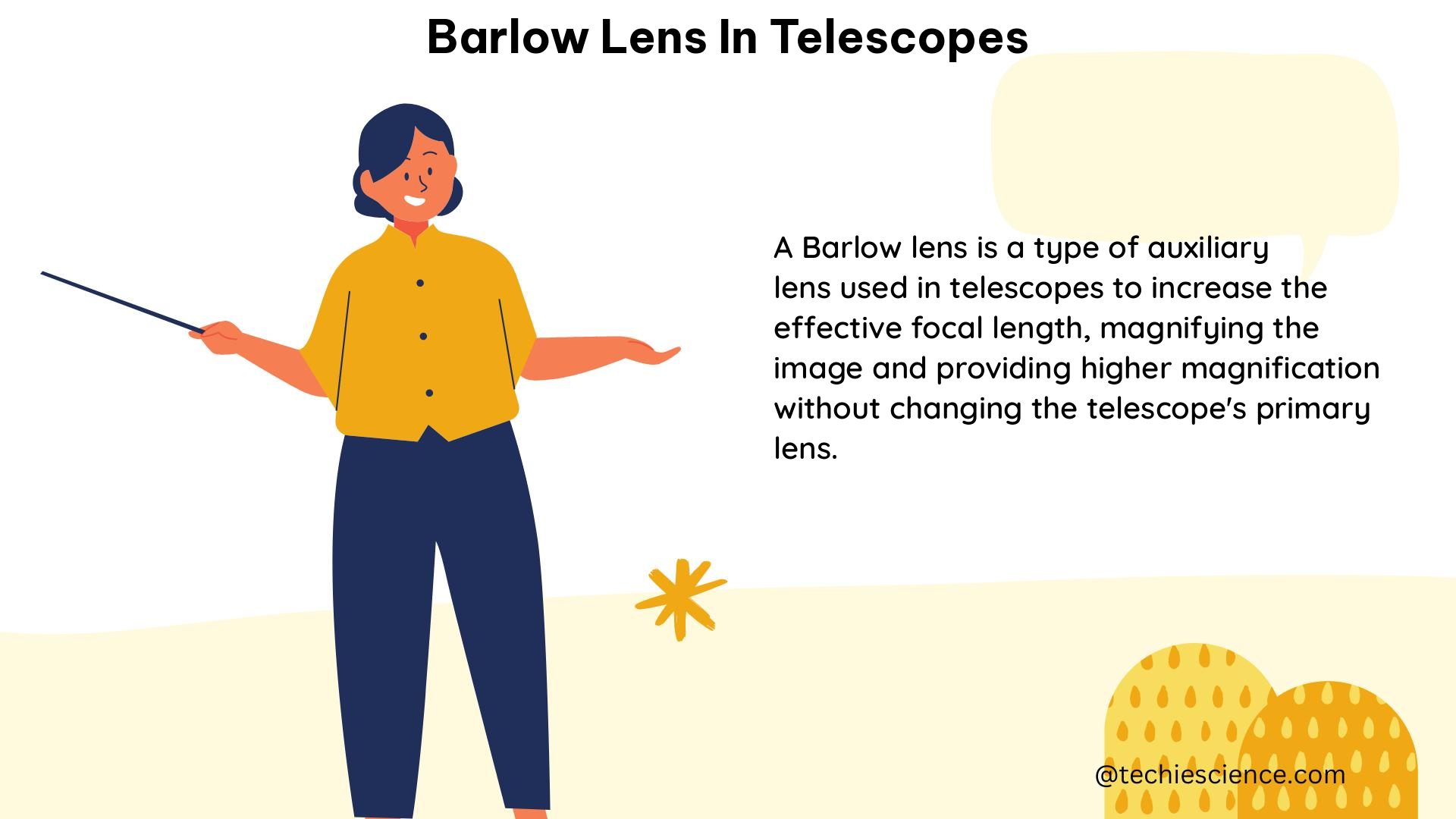The Barlow lens is a versatile and essential accessory for amateur and professional astronomers alike, offering a simple yet effective way to enhance the magnification and performance of their telescopes. By understanding the physics behind the Barlow lens and its various applications, users can unlock the full potential of their optical systems and enjoy a more immersive and rewarding observational experience.
Understanding the Barlow Lens
The Barlow lens is a type of diverging lens that is placed between the telescope’s objective lens (or mirror) and the eyepiece. Its primary function is to increase the effective focal length of the optical system, which in turn increases the magnification of the image.
The formula for calculating the magnification of a telescope with a Barlow lens is:
M = f_o / (f_e * B)
Where:
– M is the total magnification
– f_o is the focal length of the objective lens or mirror
– f_e is the focal length of the eyepiece
– B is the magnification factor of the Barlow lens
For example, if a telescope has an objective focal length of 1000mm and an eyepiece with a focal length of 10mm, the magnification would be 100x (1000mm / 10mm). However, by inserting a 2x Barlow lens, the magnification would increase to 200x (1000mm / (10mm * 2)).
Types of Barlow Lenses

Barlow lenses come in a variety of configurations, each with its own unique features and specifications. Some of the most common types include:
-
Standard Barlow Lenses: These are the most basic and widely available Barlow lenses, typically offering a magnification factor of 2x or 3x.
-
Adjustable Barlow Lenses: These lenses allow the user to adjust the magnification factor, often ranging from 1.5x to 3x or more, providing greater flexibility in the observational setup.
-
Specialty Barlow Lenses: Certain Barlow lenses are designed for specific applications, such as the Baader Q-Barlow 1.3x/2.25x, which is optimized for use with Baader Classic Plössl/Ortho eyepieces.
Each type of Barlow lens has its own unique characteristics, such as the number of optical elements, coatings, and the quality of the lens construction. These factors can significantly impact the performance of the Barlow lens, including its ability to minimize aberrations and maintain image quality.
Factors to Consider when Using a Barlow Lens
When incorporating a Barlow lens into your telescope setup, there are several important factors to consider:
-
Backfocus: The addition of a Barlow lens can affect the backfocus, or the distance between the eyepiece and the telescope’s focal plane. This shift in the focal point can be crucial for achieving the desired magnification and focus.
-
Eye Relief: Barlow lenses can also impact the eye relief, which is the distance from the eyepiece at which the user’s eye can see the full field of view. Using a Barlow lens typically increases the eye relief, making it more comfortable for eyeglass wearers.
-
Aberrations: While Barlow lenses can enhance the magnification, they can also introduce additional aberrations, such as chromatic aberration or field curvature. The quality of the Barlow lens and the overall optical system design play a significant role in minimizing these aberrations.
-
Stacking Barlow Lenses: It is possible to stack multiple Barlow lenses to achieve even higher magnifications, but this practice can lead to increased aberrations and a narrower field of view. It is generally recommended to use a single high-quality Barlow lens rather than stacking multiple lenses.
-
Magnification Limits: There are practical limits to the maximum usable magnification with a Barlow lens. As a general guideline, the maximum magnification should not exceed two times the diameter of the telescope’s aperture in millimeters or 50 times the diameter in inches.
Practical Applications and Examples
Barlow lenses can be particularly useful in a variety of observational scenarios:
-
Planetary Observation: When observing planets, a Barlow lens can provide the necessary magnification to reveal fine details and surface features, such as the cloud patterns on Jupiter or the polar ice caps on Mars.
-
Deep-Sky Imaging: Astrophotographers can use a Barlow lens to increase the effective focal length of their telescopes, allowing them to capture larger and more detailed images of deep-sky objects, such as galaxies and nebulae.
-
Lunar and Solar Observation: The increased magnification provided by a Barlow lens can be beneficial for observing the Moon and the Sun, enabling users to study surface features and phenomena in greater detail.
-
Eyepiece Projection: Barlow lenses can also be used in eyepiece projection setups, where the telescope’s image is projected onto a camera sensor or a display, allowing for high-resolution imaging and detailed analysis.
Conclusion
The Barlow lens is a versatile and powerful tool that can significantly enhance the performance of a telescope. By understanding the physics behind its operation, the different types of Barlow lenses available, and the factors to consider when using one, astronomers can unlock the full potential of their optical systems and enjoy a more immersive and rewarding observational experience.
References
- Barlow lenses, their magnification factors and working distances, Baader Planetarium, 2022-10-17, https://www.baader-planetarium.com/en/blog/barlow-lenses-their-magnification-factors-and-working-distances/
- Not Able to View Objects with Barlow Lens, Astronomy Stack Exchange, 2021-10-02, https://astronomy.stackexchange.com/questions/46935/not-able-to-view-objects-with-barlow-lens
- Measurable effect of a Barlow on eye relief?, Cloudy Nights, 2021-04-29, https://www.cloudynights.com/topic/768933-measurable-effect-of-a-barlow-on-eye-relief/
- A Guide to Barlow Lenses for Astronomy, Agena Astro, 2020-11-09, https://agenaastro.com/articles/guides/agena-guide-to-barlow-lenses
- how the hell do people use barlow lenses???, Reddit, 2023-12-06, https://www.reddit.com/r/telescopes/comments/18cg9ls/how_the_hell_do_people_use_barlow_lenses/

The lambdageeks.com Core SME Team is a group of experienced subject matter experts from diverse scientific and technical fields including Physics, Chemistry, Technology,Electronics & Electrical Engineering, Automotive, Mechanical Engineering. Our team collaborates to create high-quality, well-researched articles on a wide range of science and technology topics for the lambdageeks.com website.
All Our Senior SME are having more than 7 Years of experience in the respective fields . They are either Working Industry Professionals or assocaited With different Universities. Refer Our Authors Page to get to know About our Core SMEs.